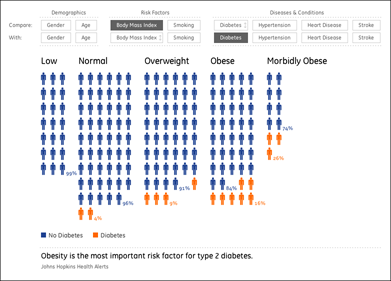Comorbidity: it’s no longer just for physicians and statisticians
A simple, interactive means for seeing connections between demographics, diseases, and diagnoses:
We just finished developing this project for GE as part of the launch of their new health care initiative. With the input and guidance of a handful of departments within the company, we began by looking at their proprietary database of 14 million patient records looking for ways to show connections between related conditions. For instance, we wanted visitors to the site to be able to learn how diabetes diagnoses increase along with obesity, but convey it in a manner that didn’t feel like a math lesson. By cycling through the eight items at the top (and the row beneath it), you can make several dozen comparisons, highlighting what’s found in actual patient data. At the bottom, some additional background is provided based on various national health care studies.
I’m excited to have the project finished and online, and have people making use of it, as I readjust from the instant gratification of building things one day and then talking about them the next day. More to come!


